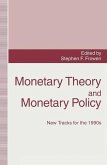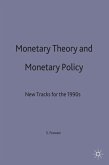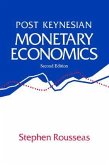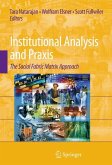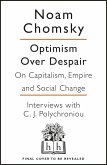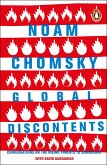Endogenous Money and the Supermultiplier
Herausgeber: Goes, Maria Cristina Barbieri; Pariboni, Riccardo; Summa, Ricardo; Dejuan Asenjo, Oscar
Endogenous Money and the Supermultiplier
Herausgeber: Goes, Maria Cristina Barbieri; Pariboni, Riccardo; Summa, Ricardo; Dejuan Asenjo, Oscar
- Gebundenes Buch
- Merkliste
- Auf die Merkliste
- Bewerten Bewerten
- Teilen
- Produkt teilen
- Produkterinnerung
- Produkterinnerung
This book explores the Supermultiplier model which has rapidly evolved into a key analytical framework, embraced and debated by Post-Keynesian economists across various schools of thought. The model extends Keynesian principles to the long run, asserting that economic growth and productive capacity arE shaped by effective demand.
Andere Kunden interessierten sich auch für
![Monetary Theory and Monetary Policy Monetary Theory and Monetary Policy]() S. FrowenMonetary Theory and Monetary Policy116,99 €
S. FrowenMonetary Theory and Monetary Policy116,99 €![Monetary Theory and Monetary Policy Monetary Theory and Monetary Policy]() S. FrowenMonetary Theory and Monetary Policy116,99 €
S. FrowenMonetary Theory and Monetary Policy116,99 €![The Cotton Industry and Trade The Cotton Industry and Trade]() Sydney John ChapmanThe Cotton Industry and Trade35,99 €
Sydney John ChapmanThe Cotton Industry and Trade35,99 €![Post Keynesian Monetary Economics Post Keynesian Monetary Economics]() RousseasPost Keynesian Monetary Economics196,99 €
RousseasPost Keynesian Monetary Economics196,99 €![Institutional Analysis and Praxis Institutional Analysis and Praxis]() Institutional Analysis and Praxis154,99 €
Institutional Analysis and Praxis154,99 €![Optimism Over Despair Optimism Over Despair]() Noam ChomskyOptimism Over Despair7,99 €
Noam ChomskyOptimism Over Despair7,99 €![Global Discontents Global Discontents]() Noam ChomskyGlobal Discontents10,99 €
Noam ChomskyGlobal Discontents10,99 €-
-
-
This book explores the Supermultiplier model which has rapidly evolved into a key analytical framework, embraced and debated by Post-Keynesian economists across various schools of thought. The model extends Keynesian principles to the long run, asserting that economic growth and productive capacity arE shaped by effective demand.
Hinweis: Dieser Artikel kann nur an eine deutsche Lieferadresse ausgeliefert werden.
Hinweis: Dieser Artikel kann nur an eine deutsche Lieferadresse ausgeliefert werden.
Produktdetails
- Produktdetails
- Verlag: Taylor & Francis Ltd
- Seitenzahl: 247
- Erscheinungstermin: 19. Juni 2025
- Englisch
- Abmessung: 246mm x 174mm
- ISBN-13: 9781041053781
- ISBN-10: 1041053789
- Artikelnr.: 73333349
- Herstellerkennzeichnung
- Libri GmbH
- Europaallee 1
- 36244 Bad Hersfeld
- gpsr@libri.de
- Verlag: Taylor & Francis Ltd
- Seitenzahl: 247
- Erscheinungstermin: 19. Juni 2025
- Englisch
- Abmessung: 246mm x 174mm
- ISBN-13: 9781041053781
- ISBN-10: 1041053789
- Artikelnr.: 73333349
- Herstellerkennzeichnung
- Libri GmbH
- Europaallee 1
- 36244 Bad Hersfeld
- gpsr@libri.de
Maria Cristina Barbieri Góes is Assistant Professor at the LINK Campus University, Rome, Italy, and the co-editor of the Review of Political Economy. Her research activity is focused on post-Keynesian economics, growth theory, fiscal and monetary policies, and income distribution. Her scientific contributions were published in various journals. Óscar Dejuán Asenjo is Full Professor of Economics at the University of Castilla - La Mancha (FCEE of Albacete, Spain). His research has been focused on: Growth and Crisis, Unemployment, Sraffian economics, Post-Keynesian economics, Input-Output analysis, The Supermultiplier model. Riccardo Pariboni is Associate Professor at the University of Siena, Italy. After three years as a Postdoctoral Fellow at the Department of Economics of Roma Tre University, he was appointed Visiting Professor at the Freie Universität in Berlin. Then, he joined the Max Planck Institute for the Study of Societies (Cologne) as a Postdoctoral Fellow. His research interests are growth theory, income distribution and Post-Keynesian Economics, but he has also worked on environmental issues and labour market dynamics. Ricardo Summa is Associate Professor at the Federal University of Rio de Janeiro, Brazil, and co-editor of the Review of Keynesian Economics. His research interests are growth theory, conflict inflation and income distribution, endogenous money in open economies and macroeconomic policies.
Introduction: The Supermultiplier and Endogenous Money 1. Finance,
Financial Adjustments and Alternative Closures in Neo-Kaleckian Models: The
Paradoxes of Thrift and Costs in the Long-Run 2. The Monetary Theory of
Production and the Supermultiplier: What Determines Savings? 3. Fiscal
Supermultiplier and Endogenous Money in the United States: The COVID-19
Pandemic vs. the Global Financial Crisis 4. Supermultiplier Models, Demand
Stagnation, and Monetary Policy: Inevitable March to the Lower Bound for
Interest Rates? 5. The Supermultiplier-Cum-Finance. An Application to the
Credit-Led Boom before the 2008 Crash 6. Pensions as an Engine of Growth.
An Approach to the Spanish Case, Based on the Sraffian Supermultiplier 7.
Components of Autonomous Demand Growth and Financial Feedbacks:
Implications for Growth Drivers and Growth Regime Analysis 8. Debt-credit
Flows and Stocks in a Supermultiplier Model with Two Autonomous Demand
Components: Consequences for Growth 9. Limits to Fiscal and Monetary Policy
in Small Open Economies 10. Impacts of US Interest Rates on Growth, Income
Distribution, and Macroeconomic Policy Space in Developing Countries: A SFC
Supermultiplier Model
Financial Adjustments and Alternative Closures in Neo-Kaleckian Models: The
Paradoxes of Thrift and Costs in the Long-Run 2. The Monetary Theory of
Production and the Supermultiplier: What Determines Savings? 3. Fiscal
Supermultiplier and Endogenous Money in the United States: The COVID-19
Pandemic vs. the Global Financial Crisis 4. Supermultiplier Models, Demand
Stagnation, and Monetary Policy: Inevitable March to the Lower Bound for
Interest Rates? 5. The Supermultiplier-Cum-Finance. An Application to the
Credit-Led Boom before the 2008 Crash 6. Pensions as an Engine of Growth.
An Approach to the Spanish Case, Based on the Sraffian Supermultiplier 7.
Components of Autonomous Demand Growth and Financial Feedbacks:
Implications for Growth Drivers and Growth Regime Analysis 8. Debt-credit
Flows and Stocks in a Supermultiplier Model with Two Autonomous Demand
Components: Consequences for Growth 9. Limits to Fiscal and Monetary Policy
in Small Open Economies 10. Impacts of US Interest Rates on Growth, Income
Distribution, and Macroeconomic Policy Space in Developing Countries: A SFC
Supermultiplier Model
Introduction: The Supermultiplier and Endogenous Money 1. Finance,
Financial Adjustments and Alternative Closures in Neo-Kaleckian Models: The
Paradoxes of Thrift and Costs in the Long-Run 2. The Monetary Theory of
Production and the Supermultiplier: What Determines Savings? 3. Fiscal
Supermultiplier and Endogenous Money in the United States: The COVID-19
Pandemic vs. the Global Financial Crisis 4. Supermultiplier Models, Demand
Stagnation, and Monetary Policy: Inevitable March to the Lower Bound for
Interest Rates? 5. The Supermultiplier-Cum-Finance. An Application to the
Credit-Led Boom before the 2008 Crash 6. Pensions as an Engine of Growth.
An Approach to the Spanish Case, Based on the Sraffian Supermultiplier 7.
Components of Autonomous Demand Growth and Financial Feedbacks:
Implications for Growth Drivers and Growth Regime Analysis 8. Debt-credit
Flows and Stocks in a Supermultiplier Model with Two Autonomous Demand
Components: Consequences for Growth 9. Limits to Fiscal and Monetary Policy
in Small Open Economies 10. Impacts of US Interest Rates on Growth, Income
Distribution, and Macroeconomic Policy Space in Developing Countries: A SFC
Supermultiplier Model
Financial Adjustments and Alternative Closures in Neo-Kaleckian Models: The
Paradoxes of Thrift and Costs in the Long-Run 2. The Monetary Theory of
Production and the Supermultiplier: What Determines Savings? 3. Fiscal
Supermultiplier and Endogenous Money in the United States: The COVID-19
Pandemic vs. the Global Financial Crisis 4. Supermultiplier Models, Demand
Stagnation, and Monetary Policy: Inevitable March to the Lower Bound for
Interest Rates? 5. The Supermultiplier-Cum-Finance. An Application to the
Credit-Led Boom before the 2008 Crash 6. Pensions as an Engine of Growth.
An Approach to the Spanish Case, Based on the Sraffian Supermultiplier 7.
Components of Autonomous Demand Growth and Financial Feedbacks:
Implications for Growth Drivers and Growth Regime Analysis 8. Debt-credit
Flows and Stocks in a Supermultiplier Model with Two Autonomous Demand
Components: Consequences for Growth 9. Limits to Fiscal and Monetary Policy
in Small Open Economies 10. Impacts of US Interest Rates on Growth, Income
Distribution, and Macroeconomic Policy Space in Developing Countries: A SFC
Supermultiplier Model


